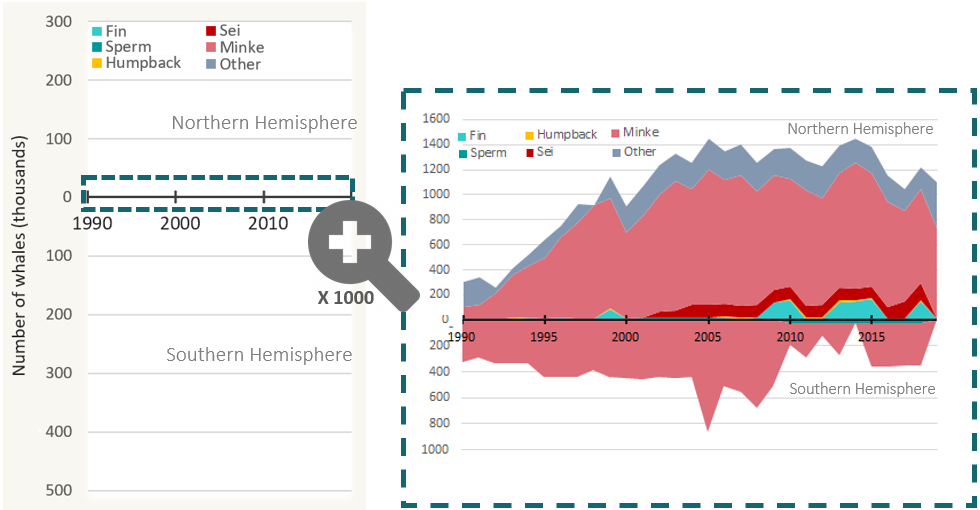Since prehistoric times, stranded or hunted marine mammals have represented resources, food and materials, for many coastal communities worldwide. Today, marine mammals are still consumed by people around the world in at least 114 countries (e.g., Robards and Reeves 2011). In the Northern latitudes, marine mammals have acquired a special significance because of their proximity, abundance and overall year-round availability compared to the scarcity and strong seasonality of the land resources in these regions. They have been a logical, compulsory and invaluable food resource for coastal communities, enabling small remote and isolated communities to survive. Still today, they represent the mainstay for many coastal communities. They bring food and money, as well as job opportunities in places where these are few, and supplement for example seasonal fishing activities.

Petroglyph found in southern Norway (Drammen) depicting hunted species, including a whale © Louis Smestad
Industrialisation
Subsistence/sustenance and coastal whaling and sealing were conducted in a largely sustainable manner, with hunting efforts and impact limited in scale and geographic extent. The scale of the impact changed with the start of commercial whaling and sealing as early as the 11th century. These systematic hunts for profit over-exploited many whale and seal stocks, particularly since the rise of industrial whaling and sealing with organised fleets in the 17th century, and the onset of modern whaling and sealing in the 1860s with the invention of the modern harpoon hun and large factory ships. Some species or stocks became virtually extinct while many were heavily depleted to 1% of their pristine abundance. Industrial whaling and sealing were indeed a blueprint for repeated over-exploitation and mismanagement.
Due to past hunting, two stocks were extirpated in NAMMCO countries; the Southwest Greenland stock of belugas by the 1930s and the Faroese stock of harbour seals by the 1860s. A dramatic reduction in harvest has allowed most other species and stocks to increase and the majority are now able to sustain controlled level of removals. In a few cases, like hooded seals in the West Ice, the decline triggered by hunting continues even though hunting has ceased, likely due to climate-induced changes.
Hunting nowadays
The present hunt is in many ways very different from the industrial whaling and sealing in the past centuries.
Purpose
The present market for marine mammal meat and other products is limited, compared to the demand for whale oil to burn lamps in the 19th century and to make soaps and margarine in the 20th century.
Scope
Twentieth century whaling took place globally, including in the high seas and Antarctica, targeting most stocks of 15 different species. Whaling was 2.5 times more intense in the Southern Hemisphere than in the Northern Hemisphere. Present whaling takes place in coastal zones and Exclusive Economic Zones, targeting only some stocks of 8 different species, mostly in the Northern Hemisphere.
Scale
Whaling and sealing today is far less intense than it was before. The graphs below show the difference in scale between whaling in the 20th century, and whaling in the past 30 years. Where between 1900 – 1989 nearly 2,900,000 whales were taken, with up to 75,000 whales a year (Rocha, Clapham, & Ivashchenko, 2014; these numbers do not include aboriginal subsistence whaling), between 1990 – 2019 this has been less than 43,000 whales in total, with a maximum of 2,300 a year.
1900-1989

1990-2019

Sustainability
Because oil was the primary product, the meat of the animal mostly was wasted. Today, meat for human consumption is the primary product of marine mammals, and most of the resource is used efficiently. Where some large whale stocks were hunted to 99% depletion in the 20th century, the stocks that are hunted today are known to be stable or increasing. Endangered stocks are protected.
Management
Whaling in sealing in the past has been mostly unregulated with a lack of knowledge of abundances and illegal hunting by some countries. There has now been significant improvement in the regulation of the hunts, monitoring of stock abundances and management and reporting, enabling the present sustainable management of stocks
References
Rocha, R. C., Clapham, P. J., & Ivashchenko, Y. V. (2014). Emptying the oceans: a summary of industrial whaling catches in the 20th century. Marine Fisheries Review, 76(4), 37-48.



